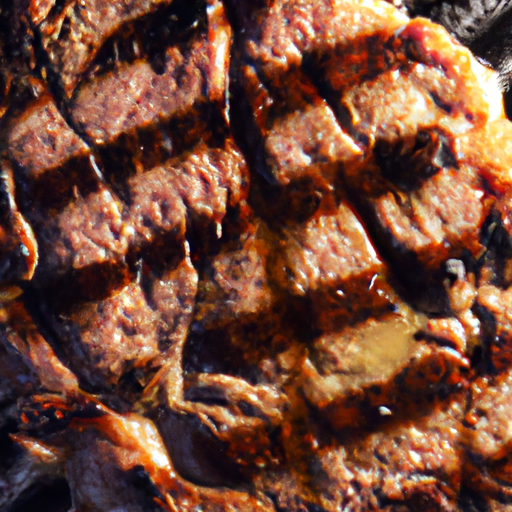So you’ve got yourself an infrared grill and you’re ready to take your outdoor cooking skills to the next level? Well, you’ve come to the right place because today we’re going to talk about how to perfectly sear meat on an infrared grill. Whether you’re a seasoned grill master or a rookie cook, this article will provide you with all the tips and tricks you need to achieve that delicious, restaurant-quality sear on your steaks, burgers, and more. So grab your tongs and get ready to turn up the heat, because your taste buds are in for a treat!
Preparation
Before you begin grilling, it’s essential to prepare your grill to ensure a successful and enjoyable cooking experience. Let’s start with the first step – cleaning the grill. Use a wire brush to scrub away any residue or debris from the cooking grates. This will not only help prevent any unwanted flavors from transferring to your meat but also ensure even heat distribution.
Once your grill is clean, the next step is to preheat it. Preheating is crucial as it helps to sear the meat quickly, locks in flavors, and creates those beautiful grill marks we all love. Simply turn on your grill and let it heat up for about 10 to 15 minutes, or until it reaches the desired temperature.
After preheating, take a moment to oil the grate. This will help prevent the meat from sticking while ensuring a nice sear. Simply take a cloth or paper towel, dip it in some cooking oil, and rub it over the grates. Make sure to do this quickly and carefully to avoid any flare-ups.
Choosing the Right Cuts of Meat
Selecting the right cuts of meat is vital when it comes to searing on an infrared grill. Opting for thick cuts of meat is key because they retain their juices better and cook more evenly. Thinner cuts may dry out quickly and can be challenging to sear properly. So, go for cuts like ribeye, strip steak, or pork chops that are at least one inch thick to achieve that perfect sear.
In addition to choosing thick cuts, using marbled cuts of meat is also essential for successful searing. Marbling refers to the white streaks of fat running through the meat. The fat melts during the cooking process, adding flavor and juiciness to the meat. Look for cuts that have good marbling, such as ribeye or T-bone steak, to enhance the searing experience.
Seasoning the Meat
Now that you have your desired cuts of meat, it’s time to season them to perfection. Applying a dry rub is an excellent way to add flavor and enhance the searing process. A dry rub consists of a mixture of spices and herbs that you can customize according to your taste preferences. Ensure that the rub is evenly distributed, covering all sides of the meat, for a balanced flavor profile.
While the dry rub adds flavor, it’s also important to add salt just before cooking. Salt helps to draw out moisture from the surface of the meat, creating a beautiful brown crust when seared. Sprinkle a generous amount of salt on each side of the meat, and let it sit for a few minutes before you start grilling.
Setting Up the Grill
With your meat seasoned and ready to go, it’s time to set up your grill for searing perfection. Begin by adjusting the heat settings on your infrared grill. Searing requires high heat, so set the burners to their maximum temperature. This will ensure that your meat gets that nice char on the outside while remaining juicy and tender inside.
Before placing your meat on the grill, remove the cooking grates. This allows you to have direct contact between the meat and the infrared grates, enhancing the searing process. Set the grates aside, allowing them to cool slightly, and get ready to sear your meat.
Searing the Meat
Now that your grill is set up, it’s time to start the searing process. Place the meat directly onto the hot grill grates, making sure to give each piece enough space to cook evenly. Avoid overcrowding the grill, as this can lead to uneven cooking and prevent that perfect sear.
When searing, it’s important to resist the temptation to flip the meat too often. Let it sit undisturbed for a few minutes to develop a beautiful crust. When the meat is ready to flip, it will naturally release from the grates. Over-flipping can result in a loss of juices and can affect the overall searing process.
Infrared grills are known to produce intense heat, which can sometimes lead to flare-ups. To deal with this, use the lid of your grill. If you notice any flare-ups, simply close the lid to smother the flames. This will prevent any excessive charring and allow your meat to continue cooking evenly.
Checking for Doneness
Determining the doneness of your meat is crucial to achieve the perfect results. While experience and intuition are valuable, it’s always best to use an instant-read thermometer to ensure accuracy. Insert the thermometer into the thickest part of the meat, avoiding any bones or fat, and check the internal temperature.
Different types of meat have different ideal temperatures for optimal doneness. For example, a medium-rare steak should have an internal temperature of around 130°F (55°C), while pork chops should reach an internal temperature of 145°F (63°C). Use cooking time as a general guideline but always rely on the thermometer for precise results.
Resting and Serving
Once your meat has reached the desired doneness, it’s time to take it off the grill and let it rest. Resting allows the juices to redistribute throughout the meat, resulting in a more flavorful and tender final product. Cover the meat loosely with aluminum foil and let it rest for about 5 to 10 minutes.
After resting, it’s time to slice and serve your perfectly seared meat. When slicing, be sure to cut against the grain to maximize tenderness. Arrange the slices on a serving platter or individual plates, and garnish with fresh herbs if desired. Now you can sit back, relax, and enjoy the fruits of your labor – a deliciously seared and juicy piece of meat straight from your infrared grill.
Grilling is an art that takes time and practice to perfect, but with these steps, you’re well on your way to becoming a grill master. So, fire up your infrared grill, follow these tips, and get ready to impress your friends and family with your seared meat prowess. Happy grilling!

